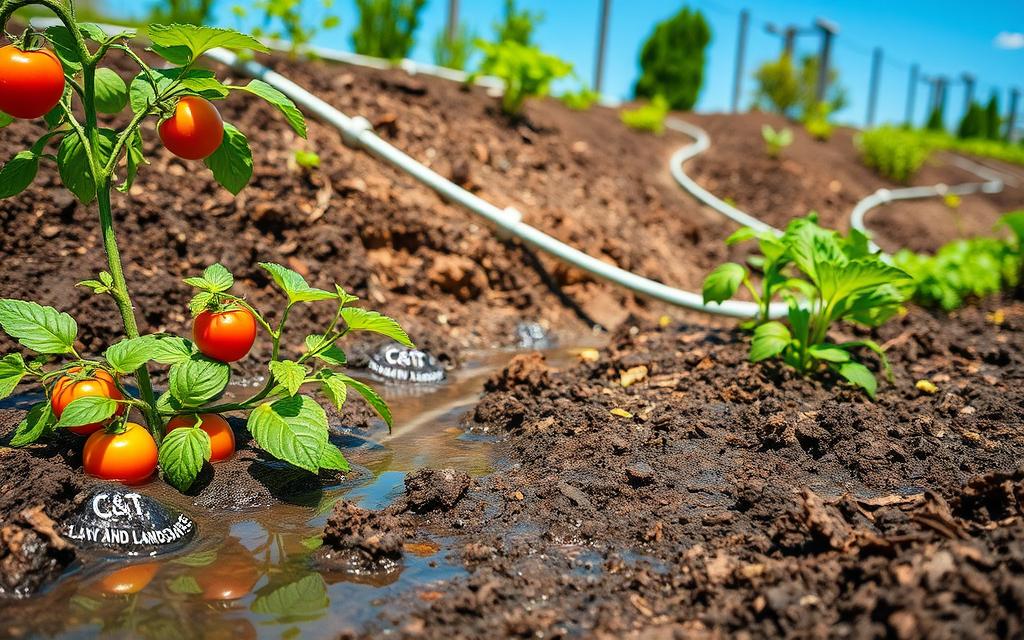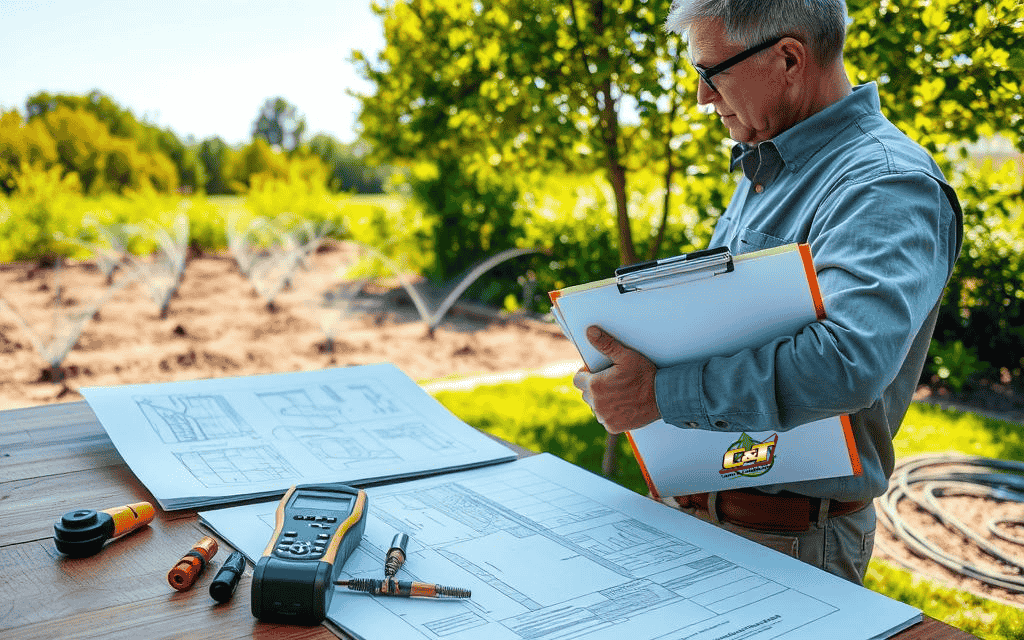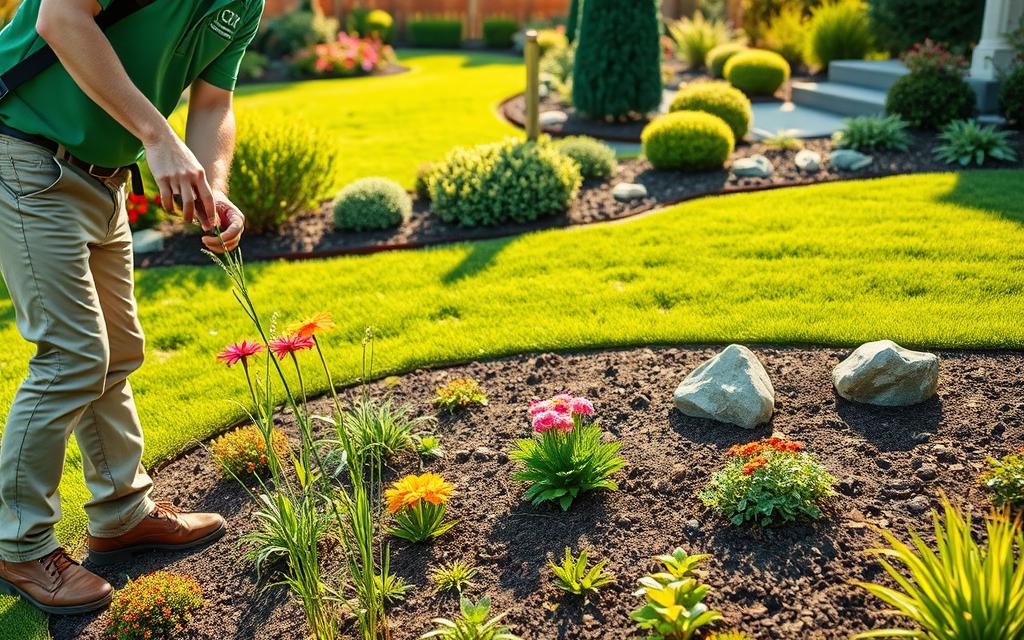When selecting a lawn water pump for 2025, you’ll want to focus on self-priming centrifugal or submersible models with smart monitoring capabilities and VFD technology. Look for pumps rated 15-30 GPM with corrosion-resistant construction and cloud connectivity for remote operation. Key features should include automatic pressure regulation, energy-efficient motors, and integration with home automation systems. Understanding the technical specifications and installation requirements will guarantee you make a suitable choice for your irrigation needs.
Understanding Water Pump Types and Their Applications
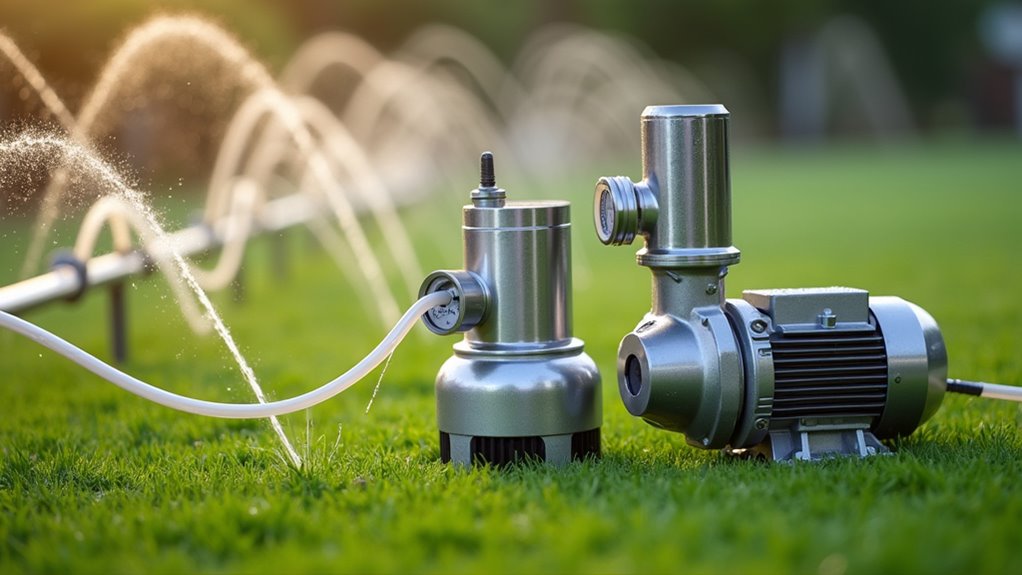
When selecting a water pump for your lawn irrigation system, understanding the core differences between pump types is essential for ideal performance. Surface centrifugal pumps offer versatility and consistent flow rates, making them a popular choice for most residential irrigation setups. They’ll efficiently draw water from your reservoir while maintaining steady pressure distribution.
For properties with varying water levels, you’ll find turbine/jet pumps particularly effective, as they combine the benefits of both surface and submersible technologies. If you’re dealing with underwater installations, submersible pumps provide reliable operation without priming requirements, though they’ll need complete submersion to function properly.
Your pump choice directly affects your sprinkler system’s GPM and PSI ratings, which determine coverage area and spray patterns. Consider these specifications carefully when matching pump capabilities to your irrigation needs.
Key Features to Consider When Selecting a Lawn Pump
Since ideal pump performance hinges on precise system matching, you’ll need to evaluate several critical specifications before making your selection. Start by gauging your required pump capacity in GPM and pressure ratings in PSI to match your irrigation system’s demands. Calculate the necessary motor power to safeguard sufficient water flow and vertical lift capabilities.
Consider energy efficiency features like VFDs, which can dramatically decrease your operating costs while preserving ideal performance. You’ll want to examine the pump’s construction materials – opt for corrosion-resistant components such as thermoplastic or cast iron to optimize durability and service life. Do not overlook self-priming capability, as this feature eliminates manual priming requirements and secures consistent operation. These technical specifications will determine your pump’s effectiveness and long-term reliability in your specific irrigation application.
Top-Rated Self-Priming Pumps for Home Irrigation
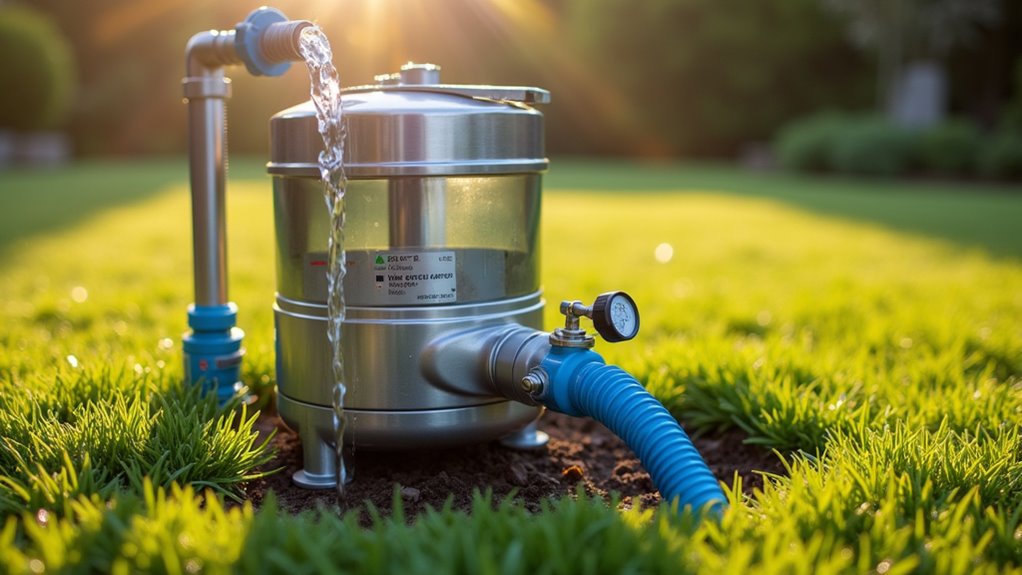
Self-priming pumps eliminate manual priming hassles by automatically removing air from the suction line, making them ideal for above-ground installations where water levels fluctuate. You’ll find that proper installation involves selecting the right location with adequate ventilation, correct pipe sizing, and guaranteeing the pump remains within 25 feet of the water source for optimal lift capacity. Regular maintenance of these systems requires checking seal integrity, cleaning strainers, and winterizing the unit to prevent freeze damage – essential steps that safeguard your investment and confirm dependable performance.
Priming Benefits and Features
Anyone who has struggled with manual pump priming will appreciate the engineering advances in today’s self-priming irrigation pumps. These advanced sprinkler pumps eliminate time-consuming manual priming while delivering consistent water flow and pressure for your irrigation systems.
Modern self-priming technology offers several key advantages:
- Automatic priming capability guarantees reliable startup performance without the need for manual water incorporation
- Augmented water pressure maintenance across your irrigation zones, with models like the Franklin Electric Turf Boss achieving 25-foot lift capacity
- Improved operational efficiency with high-flow capabilities, demonstrated by pumps like the Red Lion 76 (76 GPM) and Flotec FP5172 (67 GPM)
You’ll find these self-priming pumps available in both thermoplastic and cast iron constructions, letting you choose the ideal balance of durability and cost-effectiveness for your specific irrigation needs.
Installation and Setup Guide
Proper installation of these top-rated self-priming pumps requires careful attention to key setup parameters that directly impact performance and longevity. When installing pumps like the Franklin Electric Turf Boss or Red Lion 76, you’ll need to guarantee proper water pressure and flow optimization by positioning them within 25 feet of your water source.
For thermoplastic models like the Flotec FP5172 and FPS5000, mount them on a level, concrete surface to minimize vibration. Your sprinkler system’s efficiency depends on matching the pump’s GPM rating to your irrigation needs – the FPS5000’s 80 GPM capacity suits larger systems, while the Red Lion 33CIR‘s 33 GPM works better for modest setups. Connect your pump to the appropriate voltage source, prime the system, and check for leaks before initiating regular operation.
Maintenance Best Practices
Three critical maintenance practices guarantee peak performance of high-capacity irrigation pumps like the Franklin Electric Turf Boss and Flotec FPS5000. You’ll optimize efficiency and end up saving money by implementing these indispensable procedures:
- Regularly check seals and gaskets, particularly on self-priming models like the Red Lion 76, checking for leaks that could jeopardize suction performance and cause premature wear
- Make sure to inspect and clean the pump’s strainer basket monthly during peak season – this is pivotal for thermoplastic units like the Flotec FP5172 to prevent debris accumulation
- Perform seasonal adjustments before winter by draining water completely from cast iron pumps like the Red Lion 33CIR, and inspect the motor shaft for proper rotation when restarting in spring
Following these maintenance steps will safeguard your irrigation pump delivers consistent GPM ratings throughout its service life.
Smart Technology Integration in Modern Water Pumps
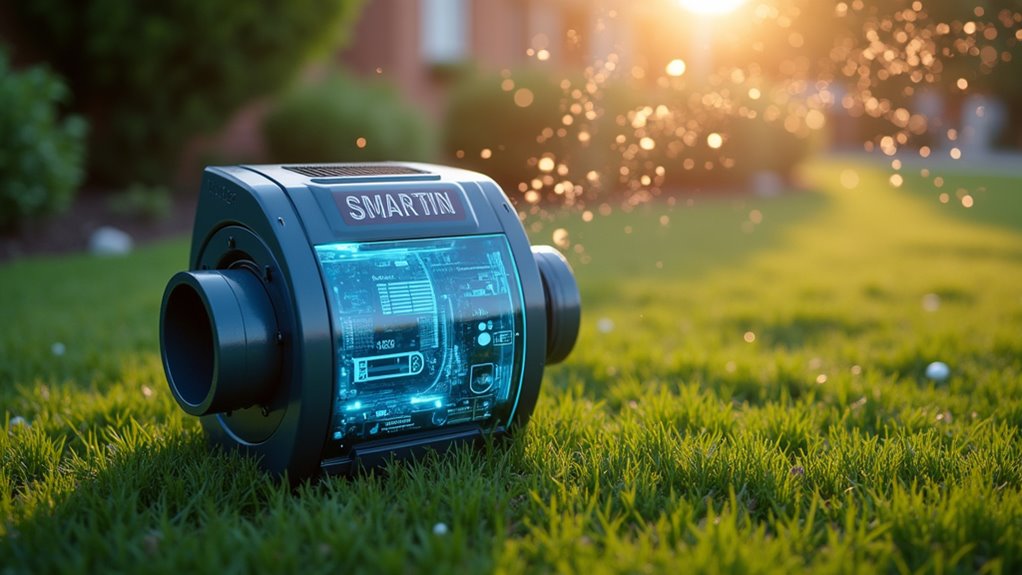
Modern irrigation pumps equip you with smart monitoring capabilities that track real-time flow rates, pressure levels, and system health through integrated sensors. You’ll gain precise control over your irrigation system through WiFi-enabled smartphone apps that let you adjust schedules, monitor water usage analytics, and receive maintenance alerts from anywhere. These intelligent systems learn from your lawn’s watering patterns and automatically optimize pump performance while providing detailed data insights to help you reduce water consumption by up to 30%.
Smart Monitoring Capability Features
As irrigation technology continues to evolve, smart monitoring capabilities have become essential features in high-performance lawn water pumps. You’ll find advanced sensors integrated with mobile apps and home automation systems that provide comprehensive control over your irrigation setup.
- Intelligent monitoring sensors detect issues in real-time, including leaks and dry running conditions, automatically adjusting pump performance to prevent damage
- Smart controllers analyze weather data and soil moisture levels, maximizing your irrigation schedule for maximum water efficiency
- Voice-enabled monitoring lets you check system status and adjust settings through simple commands to your preferred virtual assistant
These monitoring features work in conjunction with sophisticated data analytics to deliver actionable insights about your water usage, helping you achieve optimal irrigation performance while reducing water waste and operating costs.
Remote Control Via Apps
Leading the technological revolution in irrigation systems, smart water pump controllers now offer seamless remote operation through dedicated mobile applications. You’ll find the best modern irrigation solutions integrate with WiFi networks, enabling you to adjust flow rate settings and scheduling from anywhere using your smartphone.
When selecting the right irrigation pump for your lawn, prioritize models that connect to popular home assistants like Alexa or Google Home. These smart pumps, used to water your terrain efficiently, provide real-time data through cloud-based dashboards. You can monitor water consumption, track energy efficiency, and make informed adjustments to optimize performance. The latest controllers even incorporate weather forecasts and soil moisture readings to automatically fine-tune output, ensuring your lawn receives precisely the water it needs while conserving resources.
Water Usage Data Analytics
Smart technology integration has revolutionized how homeowners analyze and optimize their irrigation systems through sophisticated data analytics. You’ll gain unprecedented control over your water use through cloud-connected controllers and advanced sensors that monitor your water source in real-time.
- Smart pumps with predictive analytics detect leaks instantly, ensuring you’re never wasting water through system inefficiencies
- Cloud-based controllers automatically adjust schedules using weather forecasts and evapotranspiration data, so your lawn always gets sufficient water
- Integrated sensors measure flow rates and pressure levels, helping you use less water while maintaining ideal irrigation coverage
Your smart pump’s data analytics platform seamlessly connects with your home automation system, providing actionable insights through comprehensive usage reports. This integration enables you to make informed decisions about irrigation schedules and maintain peak system performance year-round.
Installation Requirements and Safety Considerations
Installing a lawn water pump correctly can mean the difference between ideal performance and potential system failure. You’ll need to guarantee your pumps provide consistent water pressure for sprinkler systems by following strict safety protocols during setup.
Position your pump on a solid, level foundation above the water source to prevent flooding risks. Install pressure regulators and secure all intake and discharge lines properly to work well without leaks. It’s critical to safeguard electrical connections with waterproof housings and proper grounding to eliminate shock hazards.
Maintain your system’s safety and efficiency through regular inspections. Check for loose connections, clean filters routinely, and monitor for unusual noise or vibration. These preventive measures will protect both your investment and ascertain safe operation of your irrigation system.
Maintenance Tips for Optimal Pump Performance
To optimize your lawn water pump’s performance and longevity, implementing a systematic maintenance routine is indispensable. Your irrigation needs depend on consistent flow rates per minute, making regular pump maintenance vital for reliable sprinkler head operation.
Proper maintenance routines and consistent flow rates are essential for maximizing your pump’s lifespan and ensuring reliable lawn irrigation performance.
- Inspect your pump’s components monthly, checking for wear and ensuring electrical connections are secure and properly grounded to prevent system failures.
- Clean the impeller and intake screen every 3-4 weeks during peak use seasons to maintain ideal flow rates – choose the best one for your specific system requirements.
- Winterize your pump before freezing temperatures arrive by draining all water from the system and conducting a thorough inspection of seals, gaskets, and moving parts.
Regular monitoring of operating pressure and flow rates will help you identify potential issues early, ensuring your irrigation system performs efficiently throughout the growing season.
Frequently Asked Questions
What Type of Pump Is Best for Irrigation?
You’ll find that surface centrifugal pumps are typically your best irrigation choice. They offer ideal water flow rate for most applications while keeping pump motor size manageable. You can optimize pump efficiency by matching the system to your specific needs. They’re also easier for pump maintenance and pump installation compared to other types. However, you should always assess your specific requirements, including pressure needs and water source location, before making your final selection.
What Is the Most Effective Irrigation System?
You’ll achieve maximum efficiency with a drip irrigation system augmented by soil moisture sensors and automated scheduling systems. This setup delivers water directly to plant roots, reducing waste by up to 50%. For ideal results, you’ll want to integrate water conservation techniques like pressure-compensating emitters and zone control valves. When you combine these sustainable irrigation practices with smart controllers, you’re creating a precise, resource-efficient system that maintains perfect soil moisture levels year-round.
How Many Sprinklers Can a 1.5 Hp Pump Run?
Your 1.5 hp pump’s capacity can typically support 6-8 sprinkler heads, depending on your water pressure requirements and sprinkler head coverage needs. You’ll need to examine pump placement considerations to amplify efficiency – closer to your water source is better. For energy efficient pump options, look for variable speed models. If you’re planning a larger system with more than 8 heads, you’ll want to upgrade to a more powerful pump to maintain ideal performance.
How Long Does a Lawn Irrigation System Last?
You’ll get 15-20 years from a well-maintained lawn irrigation system, though the average lifespan varies by component. Your maintenance requirements include regular inspections, winterization, and prompt repairs to maintain water efficiency. You should plan to replace sprinkler heads every 5-7 years and valves every 10-15 years. While the initial installation process represents a significant cost consideration, proper upkeep will optimize your system’s longevity and performance over time.



